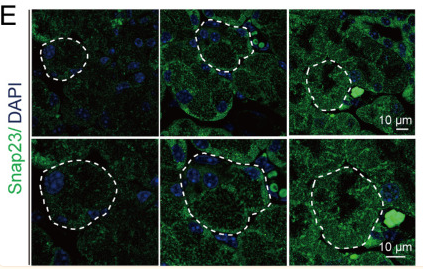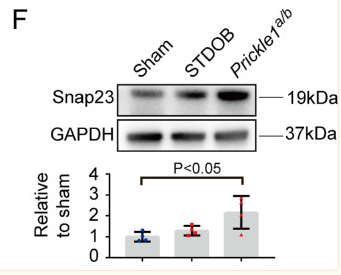SNAP23 Antibody - #DF13314
製品説明
*The optimal dilutions should be determined by the end user. For optimal experimental results, antibody reuse is not recommended.
*Tips:
WB: For western blot detection of denatured protein samples. IHC: For immunohistochemical detection of paraffin sections (IHC-p) or frozen sections (IHC-f) of tissue samples. IF/ICC: For immunofluorescence detection of cell samples. ELISA(peptide): For ELISA detection of antigenic peptide.
引用形式: Affinity Biosciences Cat# DF13314, RRID:AB_2846333.
折りたたみ/展開
HsT17016; LS-B8340; SNAP 23; SNAP-23; SNAP23; SNAP23A; SNAP23B; SNP23_HUMAN; Synaptosomal associated protein 23; Synaptosomal associated protein 23kDa; Synaptosomal associated protein; Synaptosomal-associated protein 23; Vesicle membrane fusion protein SNAP 23; Vesicle membrane fusion protein SNAP23; Vesicle-membrane fusion protein SNAP-23;
免疫原
A synthesized peptide derived from human SNAP23, corresponding to a region within the internal amino acids.
- O00161 SNP23_HUMAN:
- Protein BLAST With
- NCBI/
- ExPASy/
- Uniprot
MDNLSSEEIQQRAHQITDESLESTRRILGLAIESQDAGIKTITMLDEQKEQLNRIEEGLDQINKDMRETEKTLTELNKCCGLCVCPCNRTKNFESGKAYKTTWGDGGENSPCNVVSKQPGPVTNGQLQQPTTGAASGGYIKRITNDAREDEMEENLTQVGSILGNLKDMALNIGNEIDAQNPQIKRITDKADTNRDRIDIANARAKKLIDS
種類予測
Score>80(red) has high confidence and is suggested to be used for WB detection. *The prediction model is mainly based on the alignment of immunogen sequences, the results are for reference only, not as the basis of quality assurance.
High(score>80) Medium(80>score>50) Low(score<50) No confidence
研究背景
Essential component of the high affinity receptor for the general membrane fusion machinery and an important regulator of transport vesicle docking and fusion.
Cell membrane>Peripheral membrane protein. Cell membrane>Lipid-anchor. Cell junction>Synapse>Synaptosome.
Note: Mainly localized to the plasma membrane.
Ubiquitous. Highest levels where found in placenta.
Belongs to the SNAP-25 family.
研究領域
· Genetic Information Processing > Folding, sorting and degradation > SNARE interactions in vesicular transport.
· Organismal Systems > Immune system > Platelet activation. (View pathway)
参考文献
Application: IF/ICC Species: Mouse Sample:
Application: WB Species: Mouse Sample:
Restrictive clause
Affinity Biosciences tests all products strictly. Citations are provided as a resource for additional applications that have not been validated by Affinity Biosciences. Please choose the appropriate format for each application and consult Materials and Methods sections for additional details about the use of any product in these publications.
For Research Use Only.
Not for use in diagnostic or therapeutic procedures. Not for resale. Not for distribution without written consent. Affinity Biosciences will not be held responsible for patent infringement or other violations that may occur with the use of our products. Affinity Biosciences, Affinity Biosciences Logo and all other trademarks are the property of Affinity Biosciences LTD.







